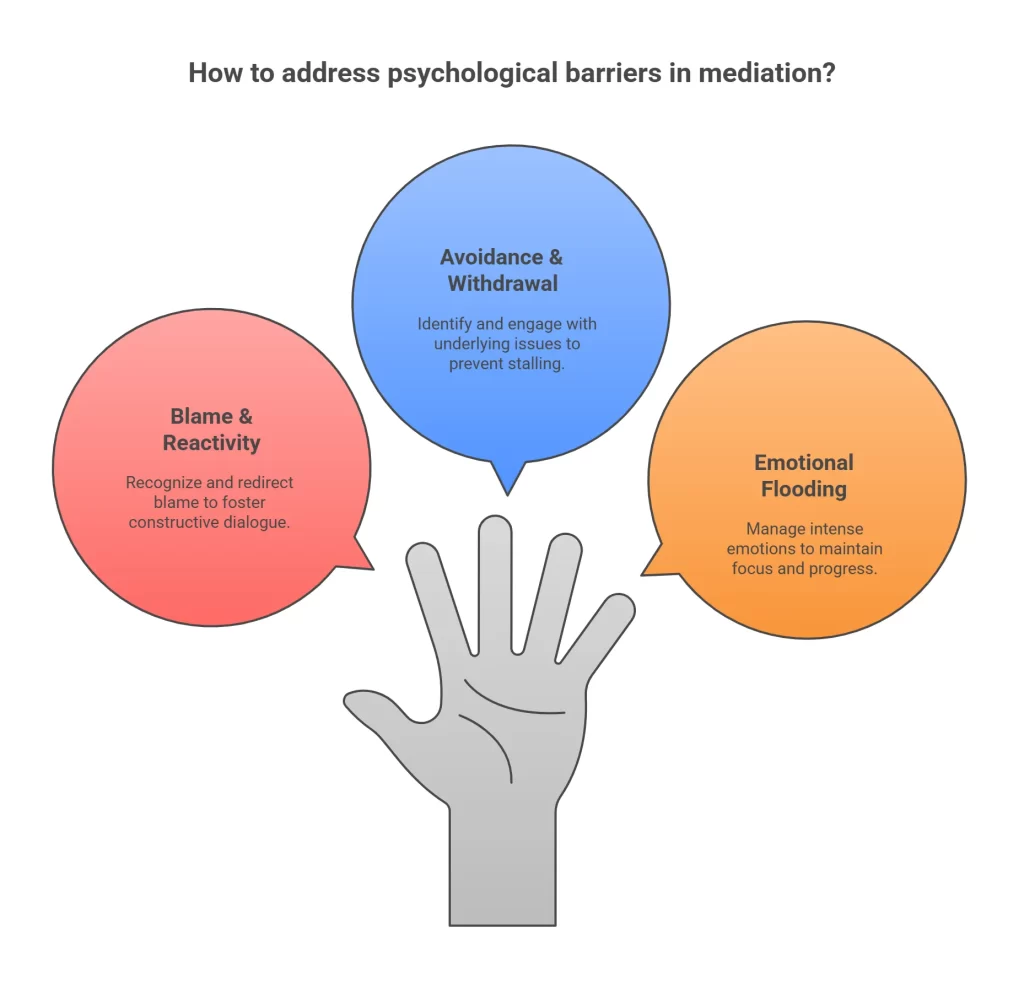

We now offer Virtual Mediations using Enhanced Video Conferencing
Originally published: March 2022 | Updated: September 2025

Divorce drags up intense emotions that can turn even simple decisions into drawn-out battles.
Understanding the psychological aspects of mediation helps couples navigate their emotions and reach more effective agreements, resulting in reduced conflict and stress.
When people know what to expect emotionally, they can prepare more effectively and work together more efficiently.
Mediation involves complex human behavior and emotions that shape how couples communicate and make decisions. Fear, anger, and grief tend to surface during sessions.
These feelings are normal, but can block progress if nobody addresses them. Divorce mediation allows couples to control their own outcome while working through these emotions in a supportive setting.
With the right mental preparation and a basic understanding of the process, people can focus on solutions rather than getting stuck on problems.

Emotional readiness impacts divorce mediation outcomes more than most people realize. It affects both negotiation power and final agreements.
Individuals who prepare emotionally before mediation tend to make better decisions and achieve more fair results.
Research indicates that individuals who are emotionally prepared reach settlement agreements 40% faster than those who enter mediation unprepared.
This speed comes from their ability to think clearly under pressure. When someone enters the divorce process without emotional readiness, they often make decisions based on hurt or anger.
Those feelings can cloud judgment and lead to shaky choices, such as those involving child custody and property division.
Emotional intelligence is crucial during divorce mediation because it enables individuals to remain calm when their spouse becomes emotional.
People who manage their reactions have more bargaining power. Prepared individuals can:
People who aren’t emotionally ready sometimes give up valuable assets or agree to unfair custody arrangements just to end the conflict.
Anyone facing divorce mediation needs to be emotionally prepared. Parents dealing with custody decisions usually face higher emotional stakes than couples without kids.
People should really focus on emotional readiness if they:
Emotional preparedness in divorce mediation involves being prepared to discuss sensitive topics, such as asset division and co-parenting plans.
Those who skip this step often regret their decisions later. The emotional readiness checklist is most effective when used 2-3 weeks prior to the commencement of mediation.
This timeline provides people with some room to practice managing their emotions and identify their true priorities.
Each person should review the checklist daily and practice staying calm when talking about tough topics with trusted friends or family.
Ann Goade offers a personalized pre-mediation readiness session to build your emotional plan, rehearse scripts, and arrive calm and prepared for mediation. Contact us to schedule.
The divorce mediation process triggers distinct emotional phases. People usually feel heightened anxiety before sessions, mixed feelings during discussions, and either relief or uncertainty afterward.
Anxiety dominates the weeks leading up to mediation. Many feel nervous about facing their spouse in a structured setting. Worrying about how discussions will go is a common concern.
Fear of conflict runs high. People often lose sleep thinking about potential arguments and may rehearse conversations in their heads.
Common pre-mediation emotions include:
Some people feel determined to reach fair agreements. Others worry they won’t get what they need from the settlement. These mixed feelings are completely normal.
Physical symptoms often show up before sessions. Headaches, stomach problems, and trouble sleeping are typical responses. The body reacts to emotional stress in predictable ways.
Relief often emerges once mediation begins. The structured format feels safer than many expected. Having a neutral mediator present takes the edge off.
Emotions can shift quickly during discussions. One moment brings frustration over disagreements. The next, maybe a spark of hope when some progress happens.
Typical in-session emotional patterns:
| Early Session | Mid-Session | Late Session |
| Nervousness | Focused discussion | Fatigue |
| Uncertainty | Problem-solving | Cautious optimism |
| Tension | Cooperation attempts | Mental exhaustion |
Surprise pops up when former spouses communicate better than expected. The mediation environment encourages respectful dialogue, which can feel refreshing after months of conflict.
Frustration builds when discussions stall on tough topics. Conversations about money and child custody can trigger strong emotions. These moments really test everyone’s patience.
Emotional exhaustion often strikes most people immediately after mediation sessions. Processing complex divorce issues drains mental energy fast. Many just want time to decompress.
Mixed feelings about agreements reached during sessions are common. People wonder if they made the right decisions. Second-guessing happens a lot in the hours afterward.
Post-session emotional recovery usually involves:
Some feel proud of their ability to communicate respectfully. Working through divorce mediation challenges builds confidence in the process.
Others experience regret about things they have said or agreed to. They might call their lawyer with concerns. These reactions usually settle within a day or two.
Progress made during sessions often becomes clearer with a little time. What felt overwhelming in the moment can seem more manageable later. Some distance gives a valuable perspective.

When couples enter divorce mediation, certain emotional patterns can stop progress in its tracks. These barriers create communication breakdowns and prevent spouses from reaching fair agreements.
Verbal cues show up when blame takes over mediation. One spouse might say, “You always” or “You never,” when discussing issues.
They may interrupt a lot or raise their voice. Their body language becomes defensive—crossed arms, leaning away, and so on.
Reactive responses happen in a flash. A spouse hears criticism and fires back with their own accusations.
This creates a cycle where both parties stop listening. Instead of problem-solving, they focus on proving who’s right.
Physical signs include:
When blame takes over, spouses can’t hear each other’s real concerns. The mediator needs to spot these patterns fast and steer the conversation back to solutions.
Some spouses simply shut down when discussing tough topics. They might sit quietly but mentally check out of the process.
Common avoidance behaviors include:
One spouse might look cooperative but never share how they really feel. They avoid conflict by not engaging at all.
This pattern hinders mediation since real issues are never addressed. The withdrawing spouse may feel overwhelmed or think their voice doesn’t matter.
Hidden resistance appears when someone agrees during sessions but later changes their mind. They may tell friends or family that they felt pressured.
Mediators need to create safe spaces for withdrawn spouses to speak up. Emotional roadblocks can prevent productive dialogue in mediation sessions.
Emotional flooding occurs when someone becomes so upset that they are unable to think clearly. Their heart starts pounding, and stress hormones surge quickly.
The logical part of the brain essentially shuts down. In that state, a spouse can’t really process info or make solid decisions.
Warning signs include:
If flooding starts, taking a break is, in fact, the best move. The overwhelmed spouse needs a little space to let their nervous system chill out.
Helpful techniques during breaks:
The mediator should pause if someone becomes overwhelmed. Interruptions during divorce mediation often reflect underlying concerns or emotional stress.
Most folks need about 20-30 minutes to recover from emotional flooding. Jumping back in too soon usually just starts the cycle over.
Changing how you see divorce mediation can turn hostile arguments into productive conversations. Simple reframing tricks and curiosity prompts help dial down emotional reactions.
The way you approach mediation significantly influences the outcome. Mediation is about creating fair solutions through collaboration, rather than focusing on winning or losing.
Try seeing your spouse as a problem-solving partner, rather than an opponent. That shift alone can change the whole vibe.
Common Reframes:
Research shows that negotiation mindsets influence outcomes more than people realize. The psychological approach matters every bit as much as the actual issues on the table.
Jot these reframes down before each mediation. Glance at them when things get heated—it really helps.
Quick mental exercises performed right before meditation can help keep you calmer and more focused. These prompts only take a few minutes, but can shift your whole approach to tough conversations.
Pre-Mediation Prompts:
Negotiation experts recommend practice and persistence to build real skills. These prompts are like a warm-up for your mindset.
Spend five minutes with these questions before each session. It makes you less defensive and opens up new avenues for agreement.
The real goal? Get genuinely curious about your spouse’s perspective. When you truly want to understand, things tend to go smoother—and sometimes, that’s half the battle.
Use this emotional-readiness checklist and book a focused pre-mediation prep call—available through Ann Goade’s mediation practice to help you rehearse and reduce stress. Contact us to schedule
Mediation goes best with some real prep and follow-through. The week before, it’s all about gathering documents and setting clear goals. On session day, you need focus and a steady mindset.
Gather up key financial documents like bank statements, tax returns, and property deeds. These help the mediator see the whole picture for property division discussions.
Financial Documentation:
If you have kids, draft your first thoughts about a parenting plan. Think about holidays, weekdays, and who decides what.
Pick your top three priorities and write them down. That list helps you stay focused when things get intense. Mental preparation reduces stress and typically yields better results.
Show up early with all your documents organized. Bring a notebook to jot down points and agreements as you go.
Day-of Essentials:
Dress comfortably but still professionally. Trust me, comfy clothes make those long sessions easier.
Take some deep breaths and remind yourself that mediation gives you real control over your divorce outcome. That mindset matters more than you think.
After each session, go over your notes while they’re all still fresh. Write down any new questions or worries for next time.
Finish any homework the mediator gives you—maybe that’s looking up childcare costs or getting a property appraisal.
Follow-up Tasks:
Keep communication with your spouse between sessions respectful and focused primarily on logistics. Save the emotional stuff for mediation, where the mediator can keep things on track.
Having a few go-to lines ready helps you stay calm when things get tense in mediation. It’s a lot easier than trying to come up with something on the spot while stressed.
The Pause Script works when you feel overwhelmed. Just say: “I need a moment to collect my thoughts. Can we take a five-minute break?”
This helps manage emotional triggers during mediation by giving you a breather before things escalate.
The Redirect Script brings the focus back to solutions. Try: “I hear that you’re upset. Let’s talk about what we both want for our children.” That shifts things from blame to shared goals.
The Clarification Script helps avoid misunderstandings. Say: “Help me understand what you mean by that,” or “Can you explain your concern more clearly?” It shows you’re trying to listen, not argue.
These scripts work because they acknowledge feelings without attacking. Plus, they buy you a little time to think before reacting.
Practice these lines out loud before mediation. Say them in front of a mirror or record yourself—yeah, it feels silly, but it helps.
Role-play with a friend if you can. Have them pretend to be your ex and throw some curveballs. This effective communication practice builds absolute confidence.
Write the scripts on index cards for a quick glance during breaks. Review them right before the session starts.
Take three deep breaths before you speak. It gives your brain a second to remember your practiced line instead of just reacting.
Good mediators use specific techniques to acknowledge tough feelings while keeping talks on track. They set clear expectations for emotional support before things even begin.
A skilled mediator employs various strategies to help manage emotions throughout the process. They establish communication guidelines from the outset.
Acknowledging Emotions The mediator validates each side’s feelings without picking sides. They know anger, frustration, and fear are just part of the process.
Setting Ground Rules: Mediators lay out rules for respectful communication. These might include:
Strategic Interventions When tensions spike, mediators step in. Sometimes they’ll separate the parties or steer the conversation in a new direction.
Present-Focused Approach: Effective mediators keep everyone focused on current needs, rather than dwelling on old arguments. That helps avoid getting stuck in the past.
Discuss with your mediator how they’ll handle emotions before you begin. Setting expectations early makes the process smoother.
Essential Questions to Ask:
Support Resources: Many mediators recommend working with a therapist in conjunction with mediation. Ask if they know any mental health pros they trust.
Session Structure Knowing how sessions run helps calm nerves. Ask about session length, how often you’ll meet, and what to expect when things get tough.
Virtual mediation requires some technical preparation and a distinct approach to reading body language.
Mediators adjust their check-ins and scripts to fit digital platforms, doing their best to work around the quirks of remote sessions.
Technical prep keeps those sensitive divorce conversations from getting derailed. You’ll want a solid internet connection—shoot for at least 25 Mbps upload speed for crisp video and audio.
Essential Equipment:
Test your setup about 24 hours before the session. Virtual mediation platforms run smoothly when everyone is familiar with the basics.
The mediator should send out detailed technical instructions a week in advance. That means links for downloading any software, info for scheduling a test call, and who to contact if things go wrong.
Lighting actually matters a lot for reading faces. Natural light from a window is great, but a desk lamp positioned behind your screen can also work well.
Keep your camera at eye level. It helps everyone feel more connected—even if it’s just on Zoom.
Room Setup Requirements:
Building rapport in virtual settings takes more intention than in-person meetings. Conversation starters and frequent emotional check-ins go a long way, especially since body language cues don’t always translate the same way on screen.
Opening Script Example: “Good morning. Before we begin, let’s double-check that everyone can see and hear clearly. If your audio’s working, just give me a thumbs up.”
The mediator should periodically mention each person’s name. Even just every few minutes helps keep people connected, especially when non-verbal communication is reduced.
Regular Check-In Prompts:
Screen fatigue creeps in after about 45 minutes. Taking scheduled breaks every hour really helps people stay focused and manage their emotions effectively.
Emotional Monitoring Techniques:
The mediator should keep backup communication methods readily available, such as phone numbers and alternative video links. You never know when tech will throw a wrench in things.
For a quick confidence boost, try a single-session emotional-coaching call focused on negotiation scripts and calming routines — mediation coaching with Ann Goade. Contact us to schedule.
Clarify your goals, identify two triggers, pick two calming techniques, rehearse three short scripts, and schedule one pre-session check-in with a counselor or coach.
Common emotions include anxiety, grief, anger, relief, and confusion — all normal; they peak at different stages and don’t mean mediation will fail.
Use a 30-second grounding routine (5 deep breaths + 3-2-1 senses), speak one “I”-statement, then request a two-minute break if needed.
Not usually; request screening, consider shuttle/caucus formats or separate counsel, and prioritize a safety plan before any joint session.
Top documents, two coping tools, three negotiation goals, one post-session contact, and a pinned 60-second grounding script to use when overwhelmed.
Postpone if you’re in acute crisis, recently hospitalized, actively suicidal, or otherwise unable to make reasoned decisions — get professional clearance first.
Yes — people who prepare emotionally negotiate more clearly, make fewer reactive concessions, and report higher satisfaction with agreements.
Editor’s Note: This article was updated in September 2025 to include new data and examples.